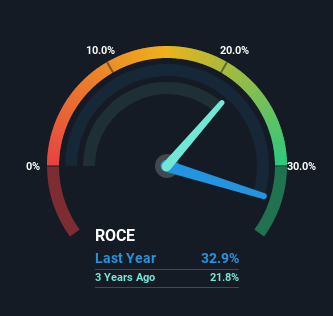Under The Bonnet, Ingersoll-Rand (India)'s (NSE:INGERRAND) Returns Look Impressive

What trends should we look for it we want to identify stocks that can multiply in value over the long term? Firstly, we'd want to identify a growing return on capital employed (ROCE) and then alongside that, an ever-increasing base of capital employed. Ultimately, this demonstrates that it's a business that is reinvesting profits at increasing rates of return. With that in mind, the ROCE of Ingersoll-Rand (India) (NSE:INGERRAND) looks great, so lets see what the trend can tell us.
Return On Capital Employed (ROCE): What Is It?
For those who don't know, ROCE is a measure of a company's yearly pre-tax profit (its return), relative to the capital employed in the business. To calculate this metric for Ingersoll-Rand (India), this is the formula:
Return on Capital Employed = Earnings Before Interest and Tax (EBIT) ÷ (Total Assets - Current Liabilities)
0.33 = ₹1.9b ÷ (₹8.6b - ₹3.0b) (Based on the trailing twelve months to December 2022).
Thus, Ingersoll-Rand (India) has an ROCE of 33%. That's a fantastic return and not only that, it outpaces the average of 16% earned by companies in a similar industry.
View our latest analysis for Ingersoll-Rand (India)

Historical performance is a great place to start when researching a stock so above you can see the gauge for Ingersoll-Rand (India)'s ROCE against it's prior returns. If you're interested in investigating Ingersoll-Rand (India)'s past further, check out this free graph of past earnings, revenue and cash flow.
What The Trend Of ROCE Can Tell Us
Ingersoll-Rand (India) has not disappointed in regards to ROCE growth. The figures show that over the last five years, returns on capital have grown by 436%. That's a very favorable trend because this means that the company is earning more per dollar of capital that's being employed. In regards to capital employed, Ingersoll-Rand (India) appears to been achieving more with less, since the business is using 48% less capital to run its operation. If this trend continues, the business might be getting more efficient but it's shrinking in terms of total assets.
For the record though, there was a noticeable increase in the company's current liabilities over the period, so we would attribute some of the ROCE growth to that. Essentially the business now has suppliers or short-term creditors funding about 35% of its operations, which isn't ideal. It's worth keeping an eye on this because as the percentage of current liabilities to total assets increases, some aspects of risk also increase.
The Key Takeaway
From what we've seen above, Ingersoll-Rand (India) has managed to increase it's returns on capital all the while reducing it's capital base. And a remarkable 302% total return over the last five years tells us that investors are expecting more good things to come in the future. In light of that, we think it's worth looking further into this stock because if Ingersoll-Rand (India) can keep these trends up, it could have a bright future ahead.
If you want to continue researching Ingersoll-Rand (India), you might be interested to know about the 1 warning sign that our analysis has discovered.
If you'd like to see other companies earning high returns, check out our free list of companies earning high returns with solid balance sheets here.
New: AI Stock Screener & Alerts
Our new AI Stock Screener scans the market every day to uncover opportunities.
• Dividend Powerhouses (3%+ Yield)
• Undervalued Small Caps with Insider Buying
• High growth Tech and AI Companies
Or build your own from over 50 metrics.
Have feedback on this article? Concerned about the content? Get in touch with us directly. Alternatively, email editorial-team (at) simplywallst.com.
This article by Simply Wall St is general in nature. We provide commentary based on historical data and analyst forecasts only using an unbiased methodology and our articles are not intended to be financial advice. It does not constitute a recommendation to buy or sell any stock, and does not take account of your objectives, or your financial situation. We aim to bring you long-term focused analysis driven by fundamental data. Note that our analysis may not factor in the latest price-sensitive company announcements or qualitative material. Simply Wall St has no position in any stocks mentioned.
About NSEI:INGERRAND
Ingersoll-Rand (India)
Manufactures and sells industrial air compressors in India.
Flawless balance sheet with solid track record.
Market Insights
Community Narratives



